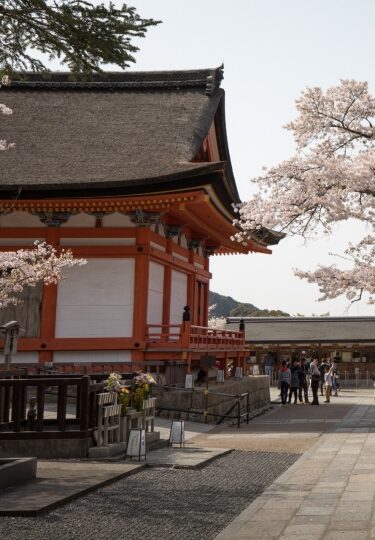The best things to do in Kyoto will include many of the sights in its central Gion District. From temples and shrines to tea houses and kimono shops, there is plenty to see.
This is the “real” Japan of wooden houses, Zen gardens, and traditional costumes that many visitors have come for. It’s a slice of history seemingly unchanged for centuries.
Beyond, there are museums and modern department stores, and the forests or bamboo groves of Arashiyama. Slightly further afield still, you can explore the delights of Nara, Osaka, and Kobe.
Be Awed by the Golden Pavilion
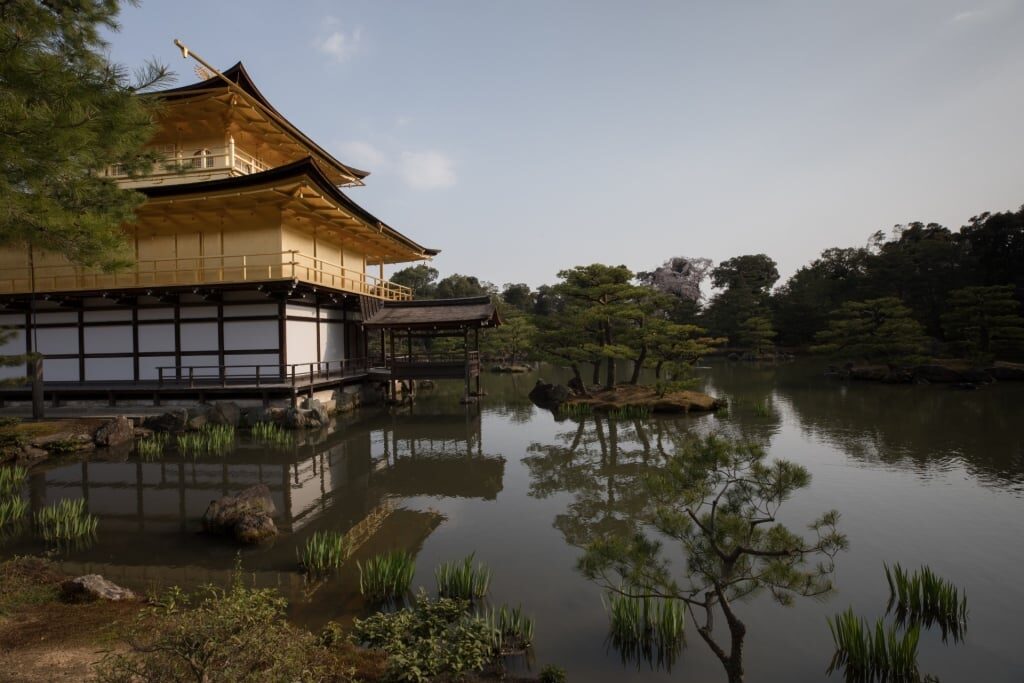
Golden Pavilion
Kinkaku-ji—best known as the Golden Pavilion—was built in 1397 as a home for a shogun (military leader). After his death in 1408, it became the glorious Zen Buddhist temple you see today.
The main building’s three floors illustrate different styles of Japanese architecture. The top two are covered in gold leaf, representing purity in Buddhism.
The building looks ancient but has been rebuilt twice in its history after fires. The last fire was in 1955, when a novice monk took exception to its perfection.
The Japanese landmark sits amid mature gardens on a tranquil pond called Kyoko-chi (Mirror Pond). The symbolism of many features around the temple grounds are best explained by a good guide.
Get Lucky at Kiyomizu-dera
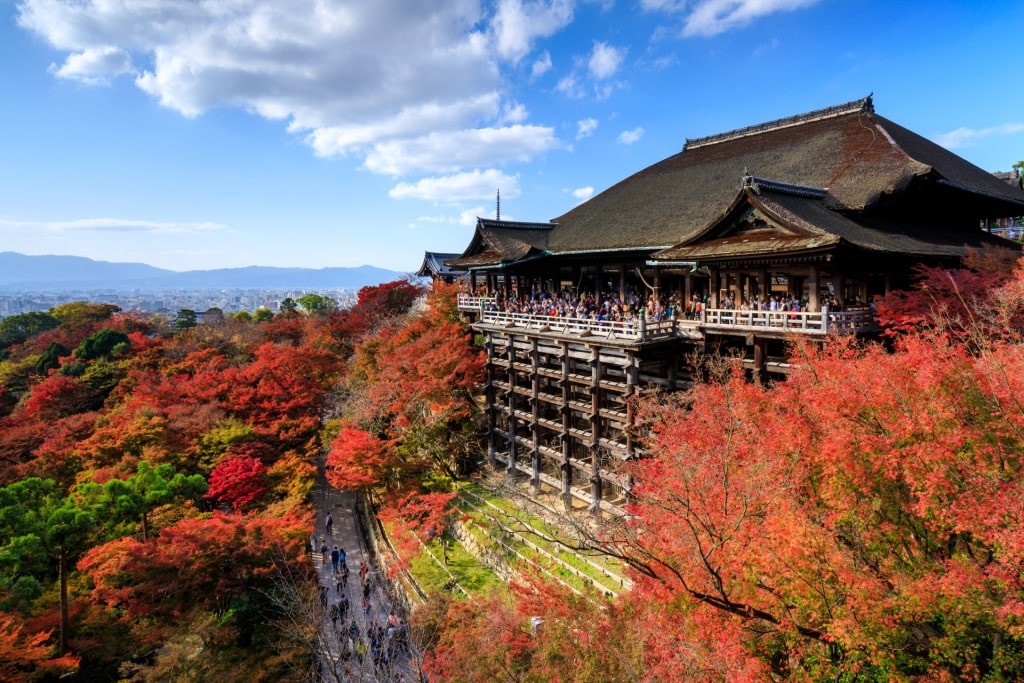
Kiyomizu-dera
One of the most beautiful places in Japan, Kiyomizu-dera (“Pure Water Temple”) stands beside the Otowa Waterfall to the east of Kyoto. The falls have three streams, which visitors drink from using cups on long poles.
One stream promises luck in love, one brings wisdom, and the third, longevity. However, you can only choose two, as it’s considered greedy to drink from all three.
Kiyomizu is also popular for its wooden terraces with photogenic views of Kyoto. One is part of the Hondo (Main Hall), the other belongs to the Okuno-in Hall.
Both halls were rebuilt in 1633, without the use of nails. That’s only one reason Kiyomizu-dera is now a Unesco World Heritage site.
Photograph the Torii at Fushimi-inari
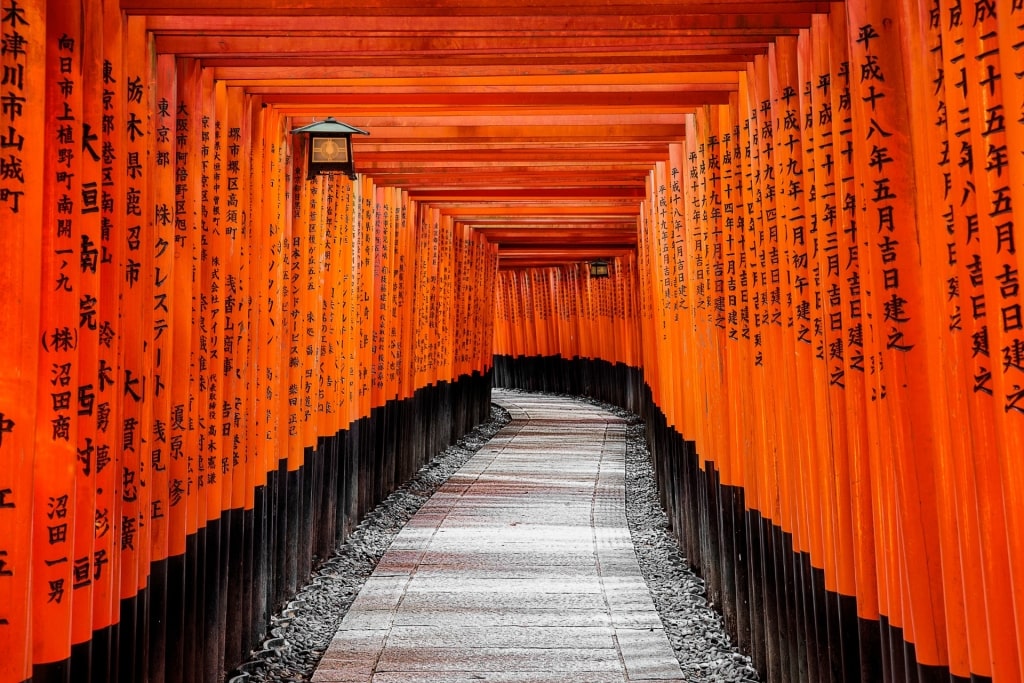
Fushimi-inari
The thousands of vermilion torii (gates) behind this notable Shinto shrine are instantly recognizable. Familiar from countless photographs and film, they are among Japan’s best torii gates.
The gates run up Mount Inari, a small hill covered in rich forest. The contrast of red gates and greenery is strikingly beautiful.
Inari is the Shinto god of rice, fertility, and business. The gates have been donated over centuries by those giving thanks to Inari or seeking his help.
The walk up Mount Inari through the torii is one of the best hikes in Japan as it ends with a panoramic view over Kyoto. As the climb takes an hour, visitors with less time to spare just take photos among the gates lower down.
Walk the Philosopher’s Path
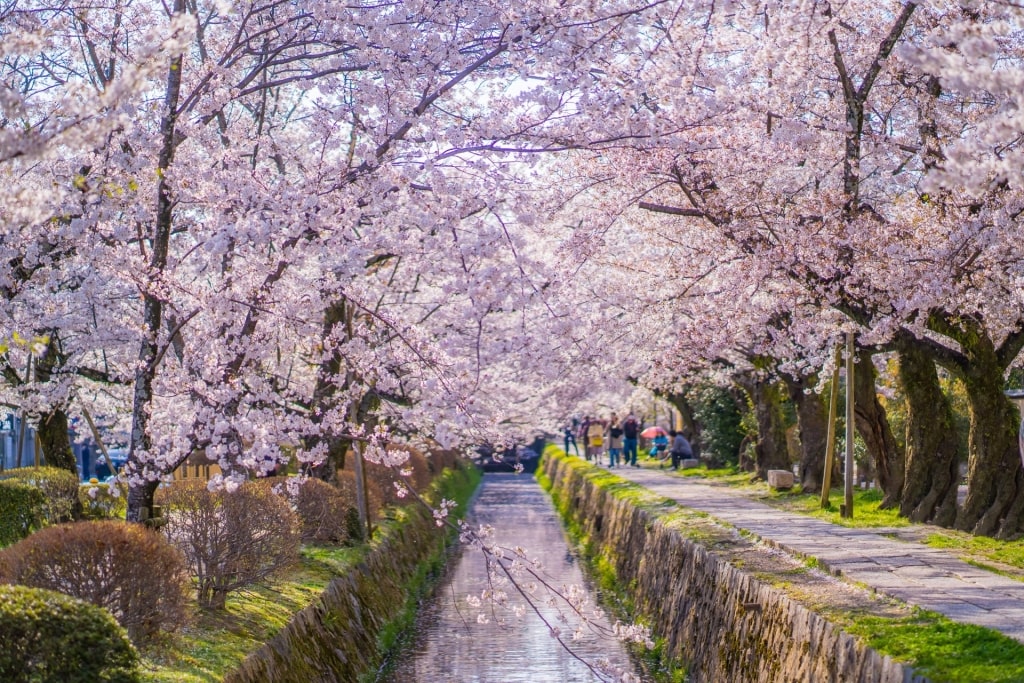
Philosopher’s Path
The Philosopher’s Path is a pleasant stone walkway more than a mile long. It follows both sides of a pretty canal in northern Kyoto, linking several important temples.
Shaded by cherry trees, the path is particularly beautiful in blossom season. It’s named for influential Japanese philosopher Nishida Kitaro (1870-1945), who found inspiration here.
Besides the temples, such as Ginkaku-ji, there are cafés and stalls selling crafts or kimonos. A common sight is red-bibbed statues of Jizo, the Buddhist deity for children.
Halfway is a landmark stone inscribed with one of Nishida’s sayings. It translates as: “People are people and I will be myself. Regardless, the path I follow, I will follow on.”
Admire the Silver Pavilion
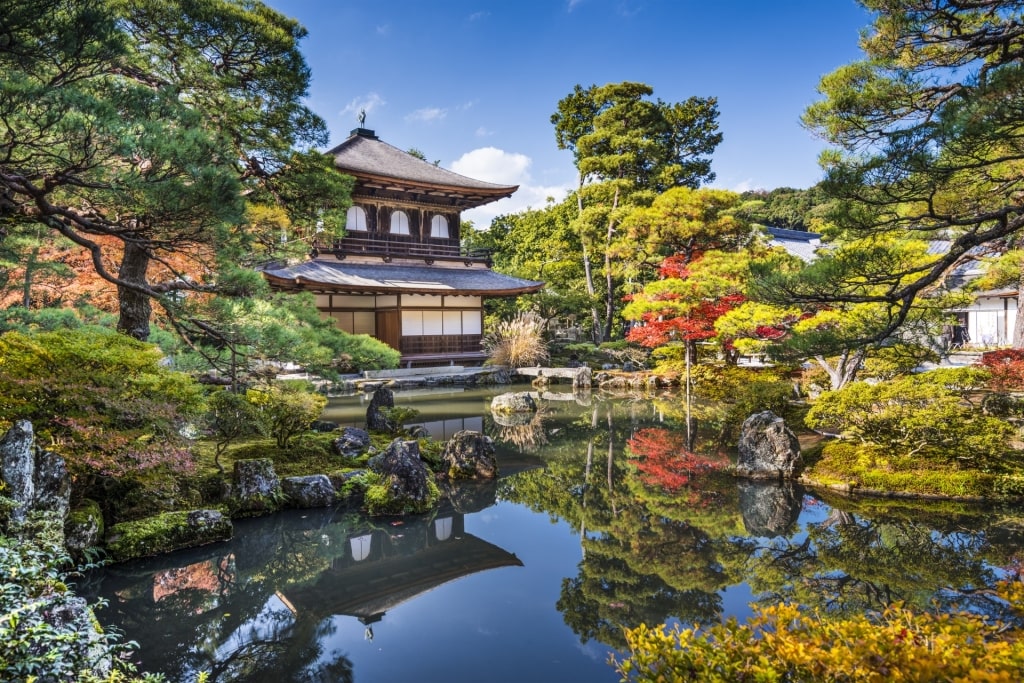
Silver Pavilion
Ginkaku-ji was built as a villa in 1482 by Shogun Ashikaga Yoshimasa. He preferred a less ornate building to his father’s Kinkaku-ji (Golden Temple) on the other side of the Japanese city.
Because of this family link, Ginkaku-ji is known as the Silver Pavilion. However, there is no silver decoration, just a simple wooden style.
Ginkaku-ji has been a Zen Buddhist temple since the 1600s. A central highlight is its raked sand garden, designed as a focus for meditation by the monks.
There is also a beautiful Japanese moss garden. Above it, there is a great view of northern Kyoto behind the temple.
Visit the Gion District
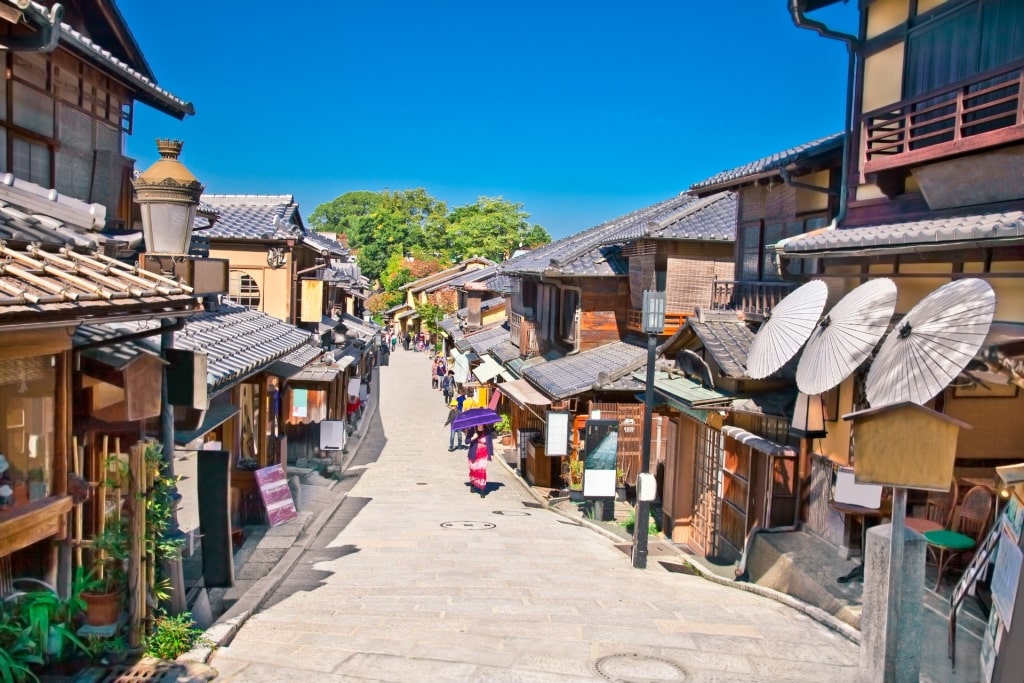
Gion District
The Gion District of Kyoto is the city’s historic heart, lined with traditional wooden buildings. It’s an atmospheric area, evocative of old Japan.
Adding to that conjuring up of the past is the potential to see a geisha or maiko (trainee geisha). They might shuffle past in traditional dress on their way to an appointment.
Sadly, the harassment these women have received from tourists has become a problem. Rather than trying to photograph them in the street, it’s best to join a tour with an organized photo opportunity.
Gion can be crowded in peak season but quiet parts remain. Wander away down side streets to find your own experience.
Photo the Yasaka Lanterns
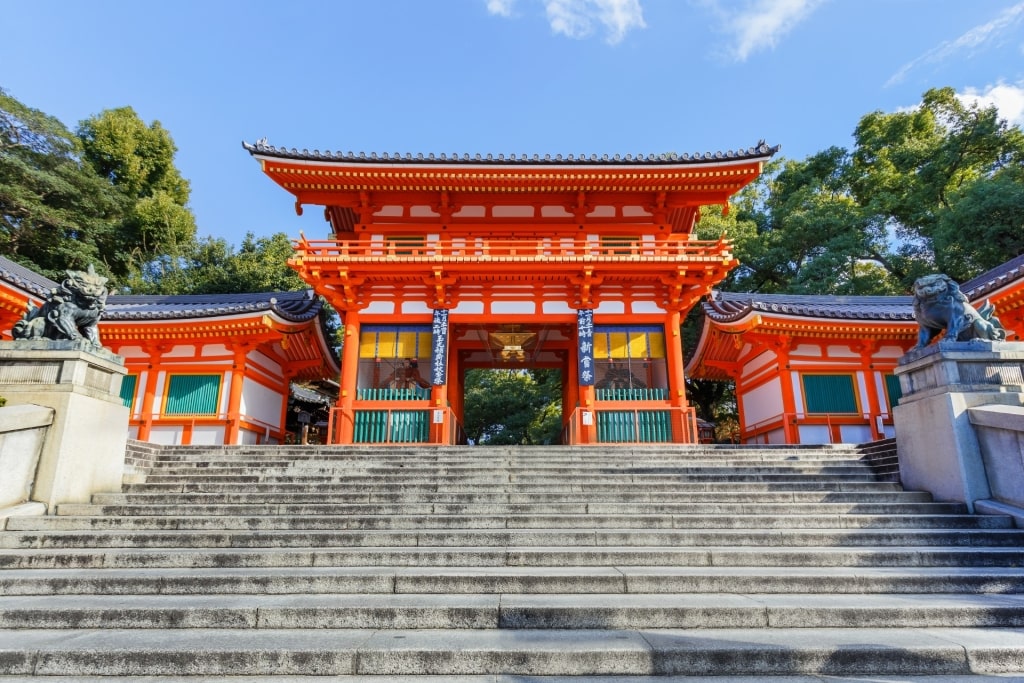
Yasaka-jinja
Yasaka-jinja is a Shinto shrine that has stood on the edge of Gion since 656 AD. Its bright red, two-story Nishiromon Gate is a major landmark.
The main hall is also colored vermilion, with a roof of cypress bark. The main stage is decorated with thousands of lanterns naming sponsors of the Gion Matsuri (Festival).
The shrine was originally dedicated to and named after Gion, giving the whole district its name. Gion is a Shinto god associated with warding off pestilence.
July’s annual Gion Matsuri is one of the most important festivals in Japan. It involves man-hauling massive floats through nearby streets in a purification ritual.
Think About Zen Meditation
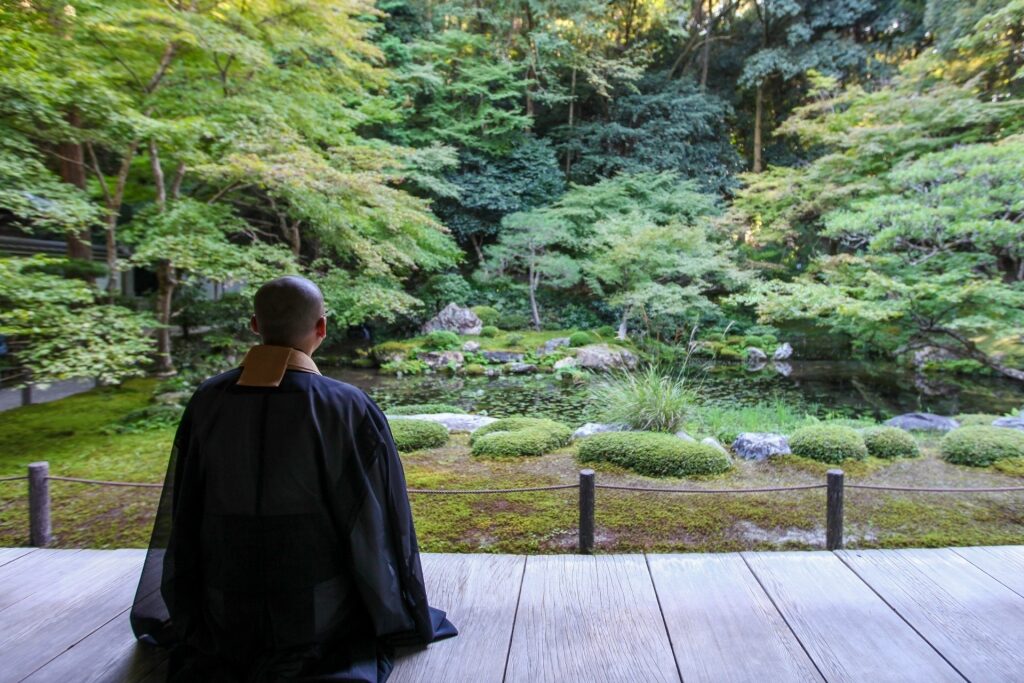
Zen Buddhist temple in Kyoto
Several Zen Buddhist temples in Kyoto offer meditation lessons. Typically lasting up to two hours, these are an amazing cultural experience, not to mention a way to reduce stress.
A leader who speaks English will guide you gently through the essentials. The purpose is to focus on your breathing, stilling your mind.
You sit cross-legged on a tatami mat (with a cushion if needed). However, chairs are provided if you prefer to use one.
After the meditation, there is time for questions and a temple tour. This is a wonderful opportunity to find out more about the life of the monks.
Experience Arashiyama Bamboo Grove
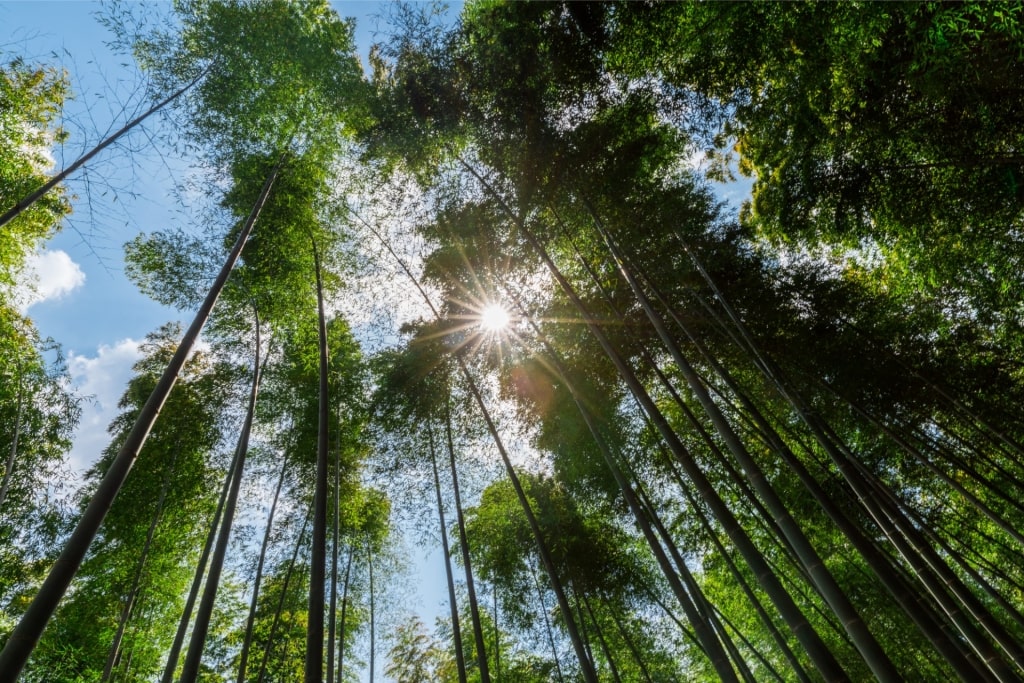
Arashiyama Bamboo Grove
The beautiful bamboo groves at Arashiyama are another recognizable image from photographs. However, a visit adds the extra dimensions of natural sounds and smells.
The breeze rustling through swaying bamboo brings an air of mystery. Filtered by the leaves, the light is also ethereal.
That other-worldliness continues at Nomiya Shrine, a pilgrimage site for those seeking marriage and children. You may see groups of young women in colorful kimonos coming to pray.
There are several other beautiful shrines, including Tenryu-ji and the Saga Toriimoto Preserved Street nearby. This last is notable for its craft shops, many specializing in objects made of bamboo.
Take in Tenryu-ji
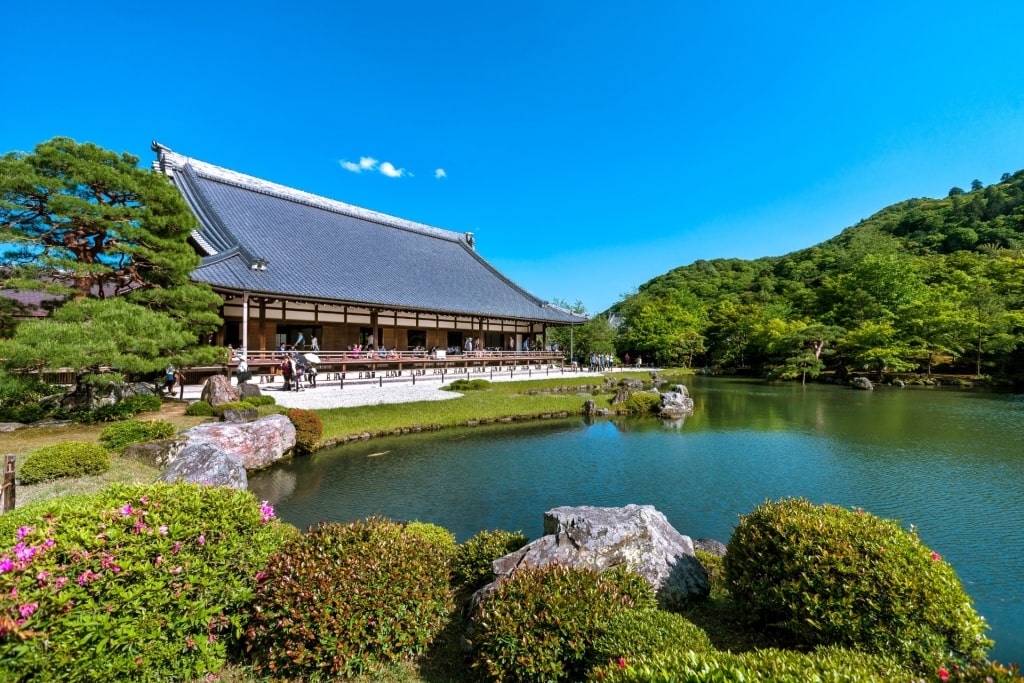
Tenryu-ji
Arashiyama’s forests, northwest of Kyoto, make it popular year-round but particularly during fall in Japan. Among them, you will find the beautiful Buddhist temple of Tenryu.
Tenryu-ji dates to 1339 and has been burnt down several times in history. The current incarnation remains a faithful and wonderful replica.
Highlights are the Tahoden (Founder’s Hall) and the massive Sanmon gate. The temple holds a statue of Buddha sculpted in the 13th century.
The tree-filled grounds include several Zen gardens, ponds, and walking paths among bamboo groves. Sogen Pond Garden is one of the oldest and best examples of Japanese garden design.
Tour Nijō Castle
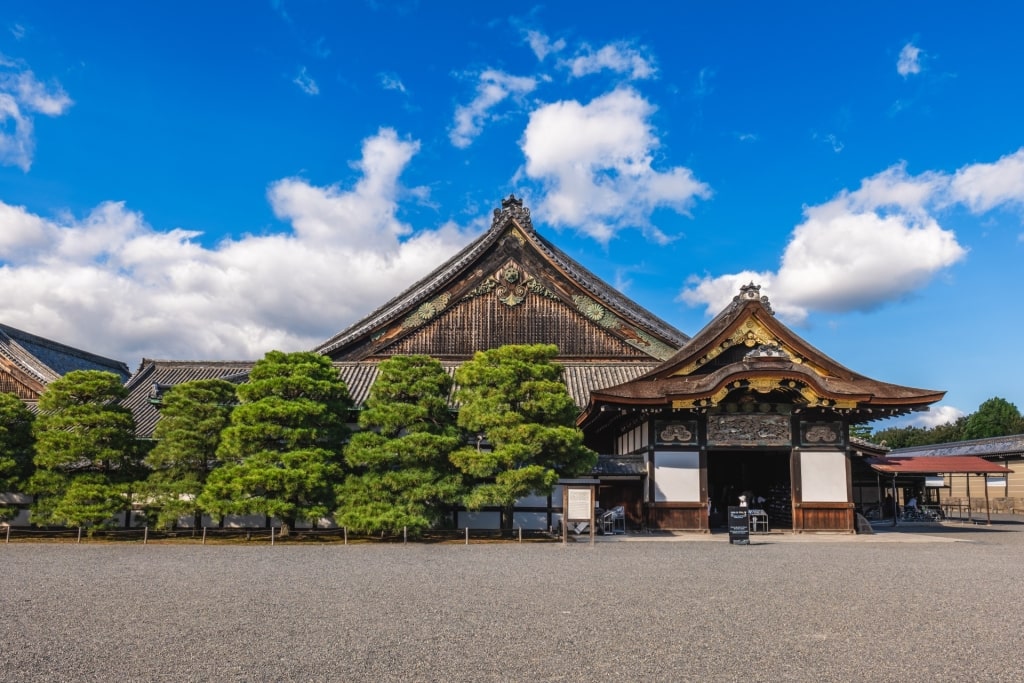
Nijō Castle
The gorgeous Nijō Castle in northern Kyoto has been central to Japanese history. It was built in 1603 for Tokugawa Ieyasu, the shogun who first unified Japan after its civil war.
With extensive grounds, stone walls, a moat, and the castle itself, there is a lot to take in. Highlights are the 33-room Ninomaru-goten Palace, the lion-bedecked Kara-mom Gate, and the classical Ninomaru Garden.
Among the many individual delights, the “nightingale floors” stand out. These were designed to squeak when walked on, acting as an alarm against intruders.
The paintings and wood carvings throughout are a major sight in themselves. The paintings you see in the castle are reproductions, with the originals on display in a dedicated gallery.
Contemplate A Rock Garden
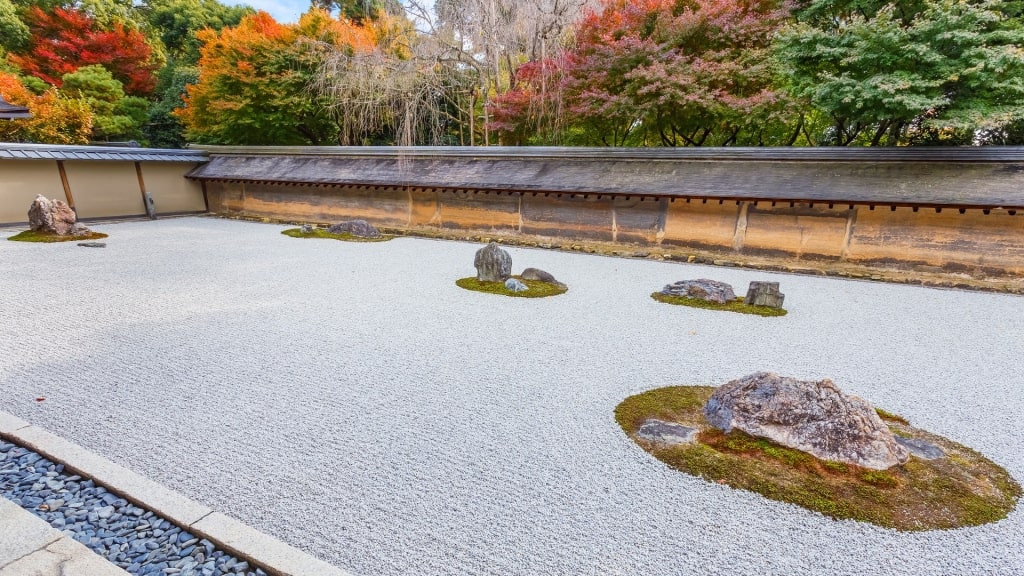
Ryoan-ji
Ryoan-ji (Peaceful Dragon Temple) is a Zen Buddhist temple in northwest Kyoto. Its karesansui, or dry landscape garden, has become a model for many others around the world.
The minimalist design has 15 rocks arranged in small groupings on white pebbles. These evoke islands in the ocean or mountains on a plain.
The rough garden wall brings in the spirit of “wabi-sabi”, or finding beauty in imperfection. The whole is designed for you to project your own thoughts onto it.
The temple grounds include ponds and other landscape gardens. Paths wind through groves of trees with each bend delivering new vistas.
Discover Kyoto National Museum
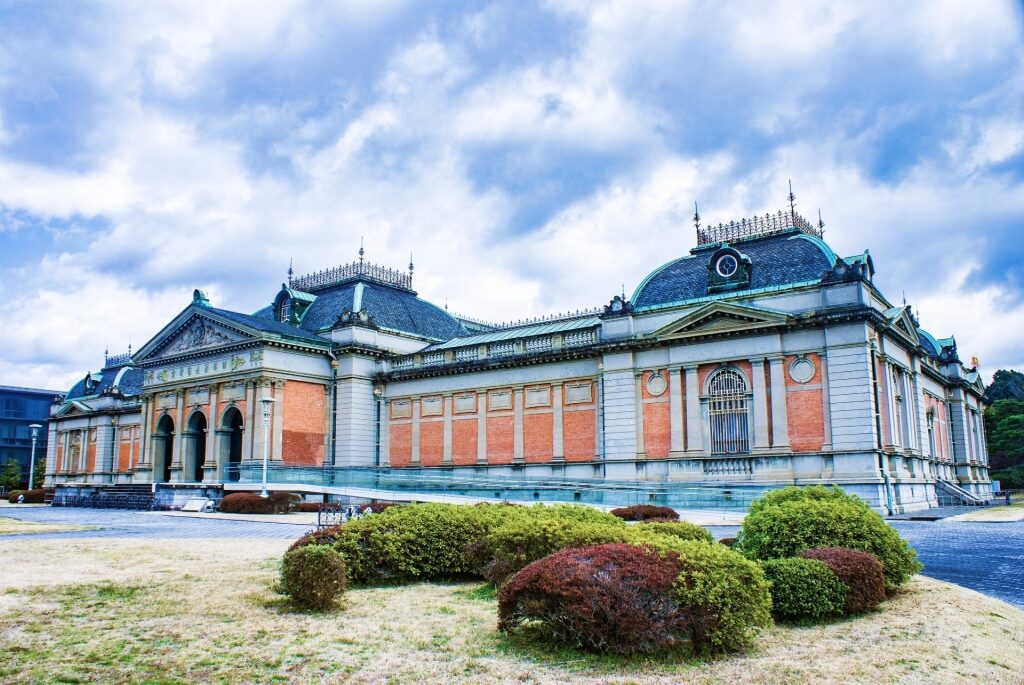
Kyoto National Museum
Kyoto National Museum is one of Japan’s four major national museums. Its collection contains priceless works in sculpture, ceramics, calligraphy, textiles, and archaeology.
The original museum was built in 1895 in red brick “Imperial Palace” style, now out of favor. However, its mix of western and Japanese influences is of significant historical interest.
A strikingly modern building by Taniguchi Yoshio (redesigner of New York’s MOMA) now holds the main collection. That concentrates on the Heian Period (794-1185), when Kyoto was the capital of Japan.
Annual special exhibitions feature spectacular pieces from other collections. The museum gardens are well worth a visit on their own.
Eat at Nishiki Market
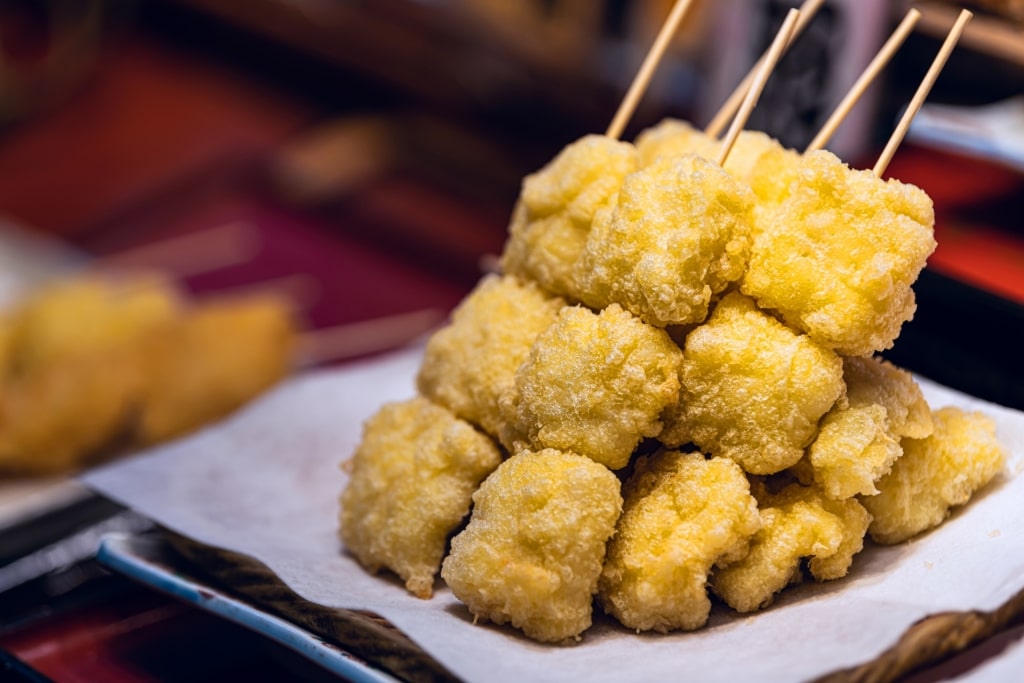
Nishiki Market
We all love a good produce market and Kyoto’s Nishiki is one of the most colorful. It’s also a great place to try some local specialties.
Foods to try in Kyoto include deep-fried hamo tempura and yuba sashimi. Hamo is conger eel, while yuba is the skin formed on simmering tofu (like the skin of boiled milk).
Join a tasting tour with a local guide to learn more about such local foods and the market itself. As with anywhere dealing in fresh food, get there early to see the real action.
The market also has hundreds of shops selling everything from pickles (a Japanese passion) to high quality rice wines. There’s also kitchenware, souvenirs, a buzzing café, and a temple.
Browse Shinkyogoku
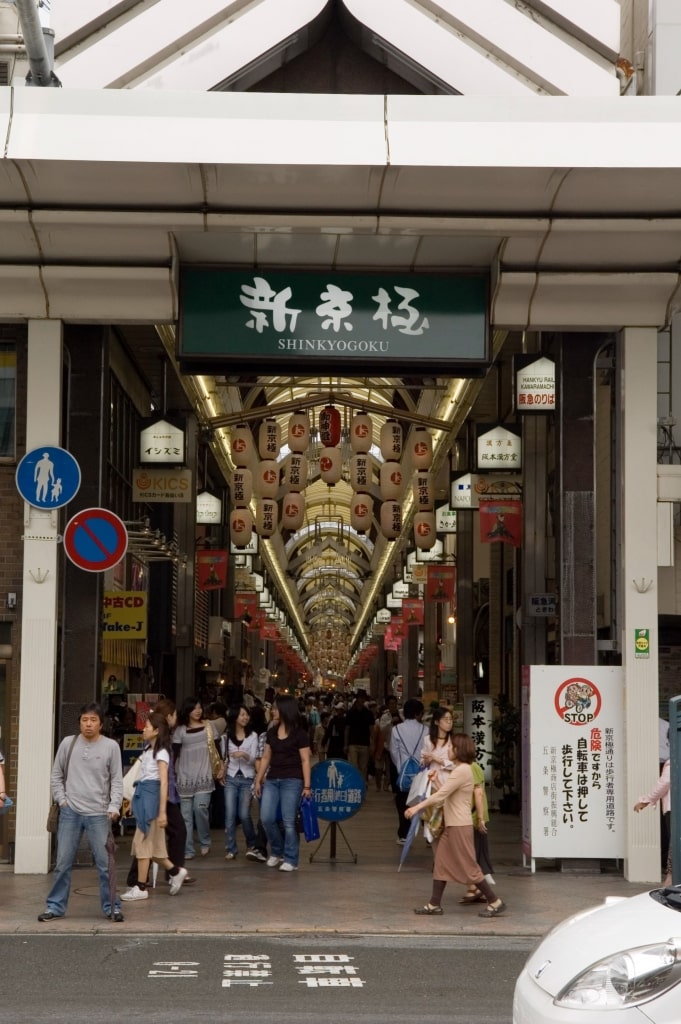
Shinkyogoku Photo by Daniel Ng on Flickr, licensed under CC BY 2.0
Shinkyogoku is a covered arcade in traditional style with more than 100 shops, cafés, and restaurants. It’s a great place to spend hours looking for gifts, clothing, or just people watching over a coffee.
For Japanese souvenirs, check out the Kyoto-style pottery, woodblock prints, and wooden “geta” sandals. Among the smaller local shops are a few big-name brands such as the trendy fashion chain, Uniqlo.
You can’t go far in Japan without passing a food stall. Here’s where you can find Kyoto-style confectionery, sushi, and lots of fragrant teas.
No cook will want to leave Japan without a good new knife in their checked baggage. You have plenty of choice here, as well as exquisite bowls and other kitchenware.
Find Refuge at Heian Shrine
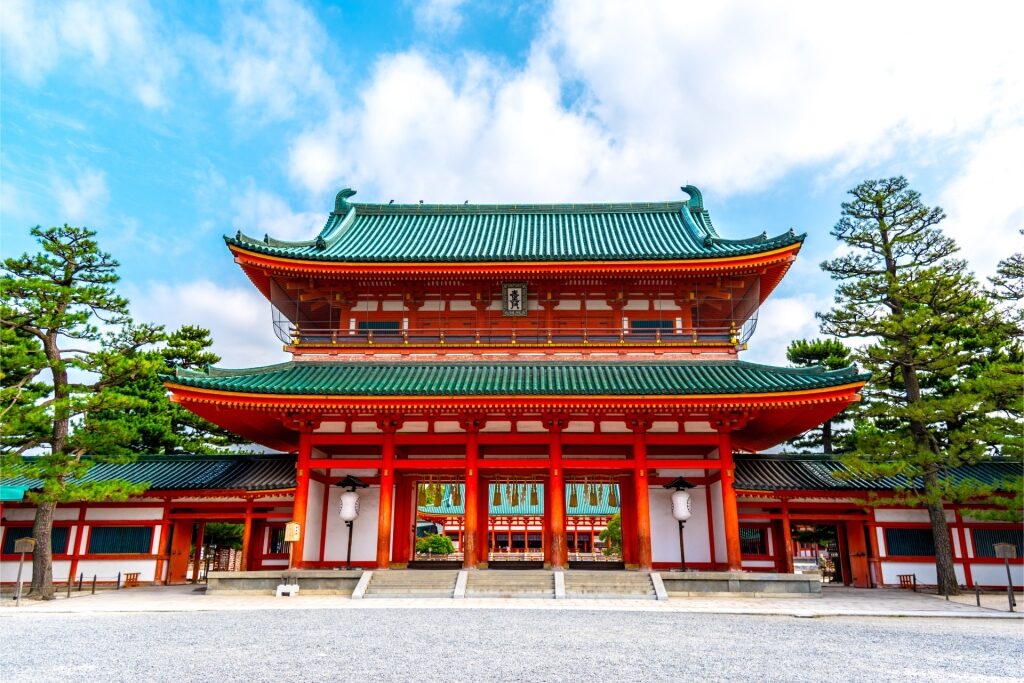
Heian Shrine
Heian Jingu is one of the most popular Shinto shrines that Kyoto is known for. It was built in 1895 to mark the 1,100th anniversary of Kyoto as the Heian imperial capital.
Its buildings and gardens emulate the style of the imperial palace of that ancient era. Built using traditional methods, the Main Sanctuary and Worship Hall are connected by a distinctive corridor.
The 80-ft-high torii at the entrance was the largest in Japan when it was built. It is still the largest in Kyoto and remains a popular photo opportunity.
The shrine’s remarkable Shin’en Garden is a lovely refuge, right in central Kyoto. Taking two decades to lay out, it features traditional landscaping with tranquil ponds and scenic bridges.
Go Green in the Botanical Gardens
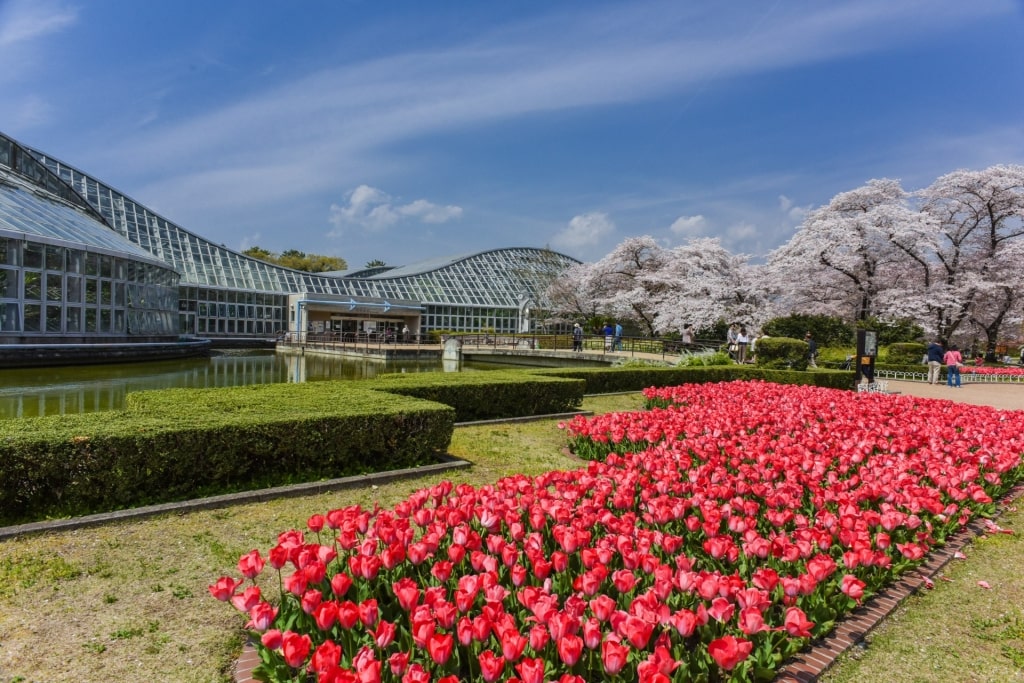
Kyoto Botanical Gardens
If you like the art of bonsai, the Kyoto Botanical Gardens will inspire you. Its large collection of these miniature trees includes many masterpieces of the art.
The 60-acre garden has thousands of other (life-sized) plants arranged in different settings. A vast conservatory has desert, tropical and highland zones, among others.
One of the most lovely sights, perhaps no surprise, is the formal Japanese Garden. There is also a bamboo grove and hundreds of cherry trees.
With lots of seating and a small café, this is a great spot to linger in. Its 12,000 plants mean there is something in bloom at any time of the year.
Go Up Kyoto Tower
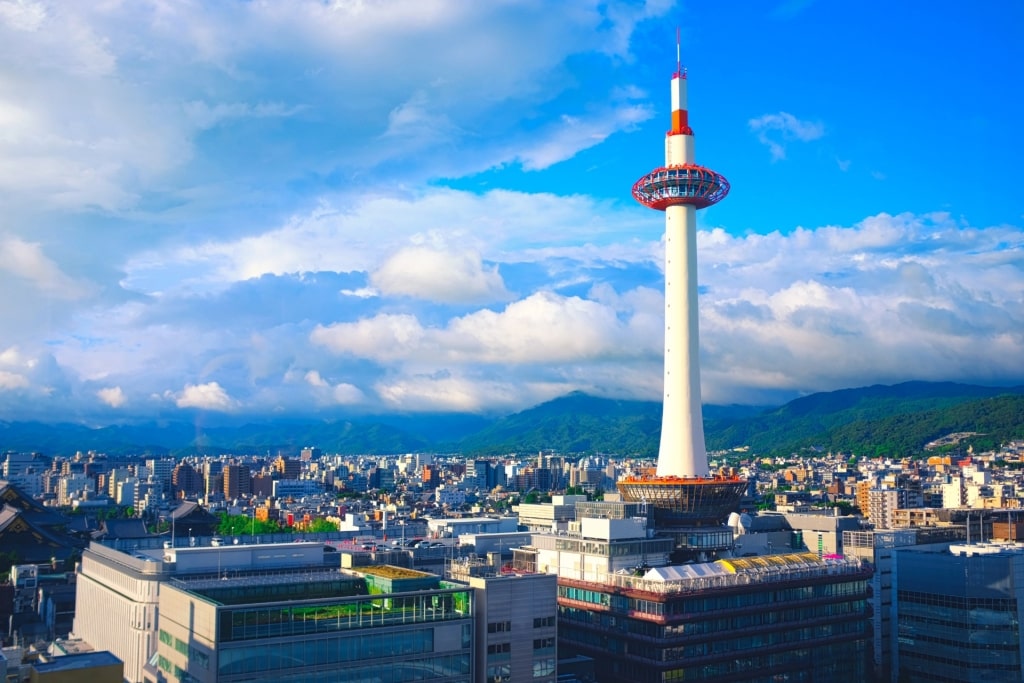
Kyoto Tower
The modern side of Kyoto was deliberately emphasized with the building of Kyoto Tower in 1964. It’s still a major landmark on the skyline and the observation deck enjoys panoramic views of the city.
The tower is 430 feet tall, with a bright red steel frame. Its base is a multi-story building with restaurants, shops, and a theater complex.
It stands near Kyoto Station among a series of other modern developments in the city center. With the passing tide of commuters and shoppers, the whole area is a magnet for photographers.
Ride a Shinkansen
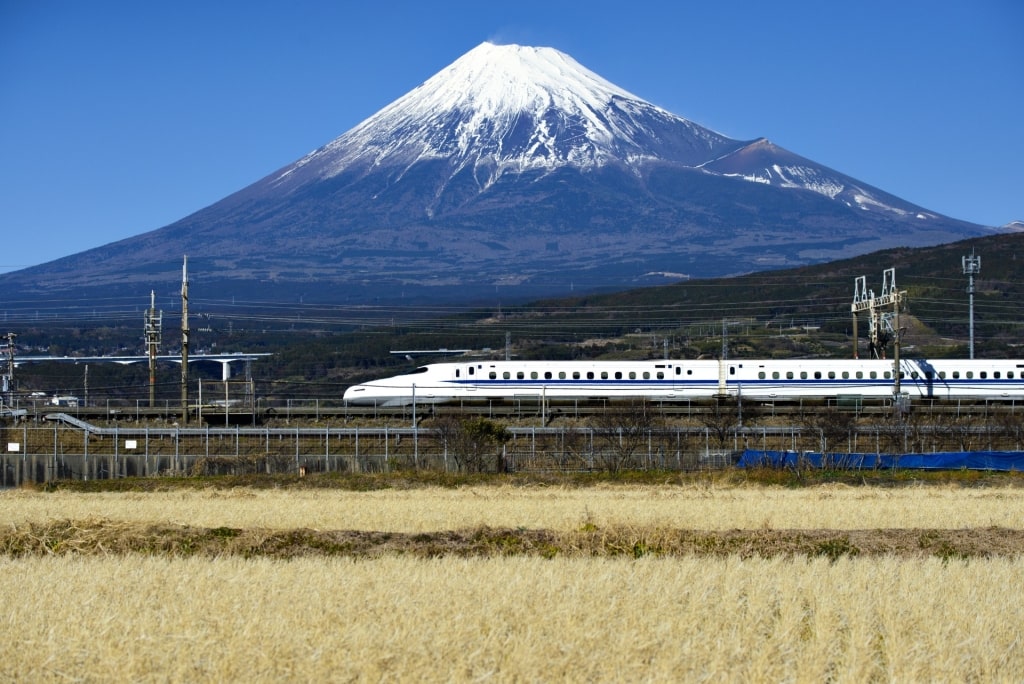
Shinkansen
The Shinkansen, or “Bullet Train” is an iconic image of modern Japan. Reaching speeds of up to 200mph, these trains are so punctual that any delays are measured in seconds.
Riding a Shinkansen is an experience any traveler to Japan must have. Quiet, smooth, and comfortable, nothing beats being whisked to your destination with a window on the Japanese countryside.
There are three classes, with options such as electronic reclining seats or a carriage attendant. Even the on-board catering is outstanding, with choices such as self-heating bento boxes.
For visitors to Kyoto, the obvious route to try is the link to Osaka. The distance of 27 miles from Kyoto Station to Shin-Osaka Station is covered in 14 minutes.
Be Awed by Osaka Castle
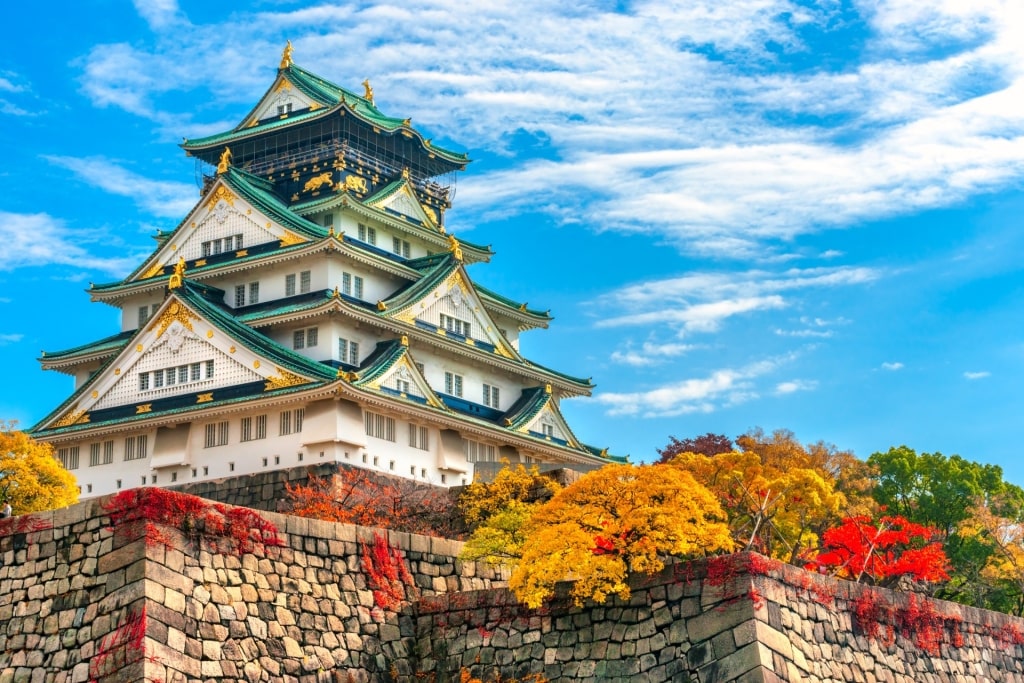
Osaka Castle
Osaka Castle dominates the center of Osaka, about an hour from Kyoto. You can see it from Shinkansen trains as they enter or leave the city.
The impressive central building Osaka is known for is eight stories tall and is decorated with intricate green tiles. Although the castle was first built in 1583, this is now a modern replica, made fire-proof with a concrete core.
This keep stands on a large hill protected by a complex set of walls, moats, turrets, and gates. A museum exhibits artifacts and other remnants of the older castles.
In the grounds, you’ll find lush gardens and quiet shrines. The number of cherry trees and the scenic castle background make for big crowds when the trees blossom in spring.
Thrill to Dotonbori
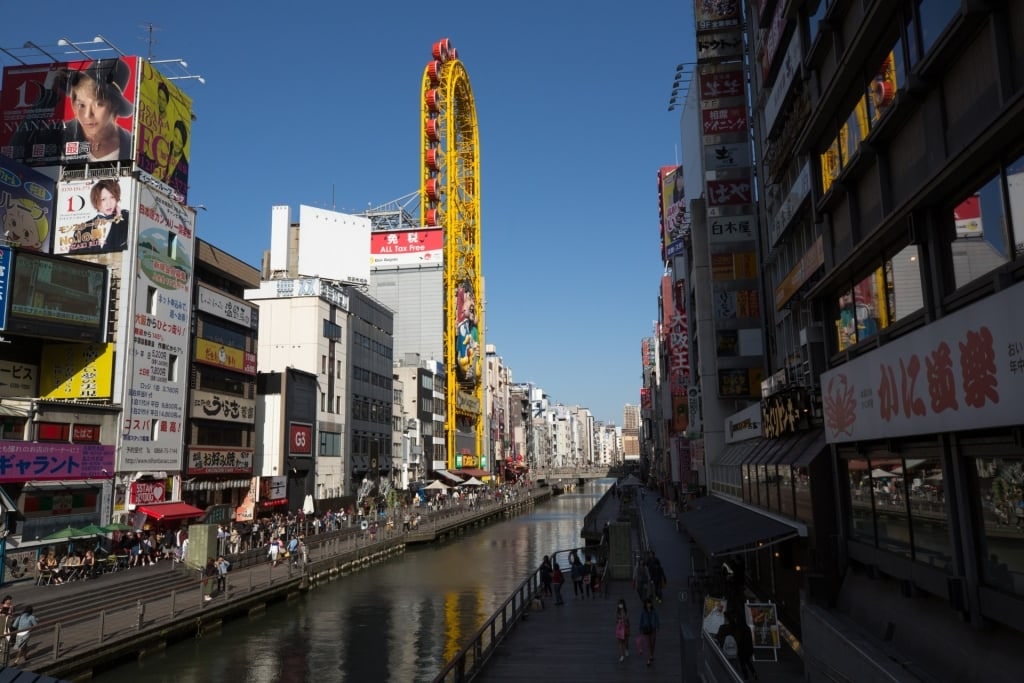
Dotonbori, Osaka
Dotonbori is the central entertainment and food district of Osaka. Its most famous sight is the giant neon signs reflected in the Dotonbori canal.
The area is a gourmet’s delight, with plenty of interesting restaurants. You’ll soon discover why Osaka is known as “Japan’s kitchen”.
At night, it’s a sensory overload of lighting, noisy bars, clubs and gaming parlors. During the day, it’s fun to watch dance groups practicing along the canal or teens showing off outlandish costumes.
One haven of quiet is the Hozen-ji, a temple covered with thousands of faded Buddhist decorations. Don’t leave Dotonbori without photographing the landmark Glico running man.
Go Sightseeing on Mount Rokko
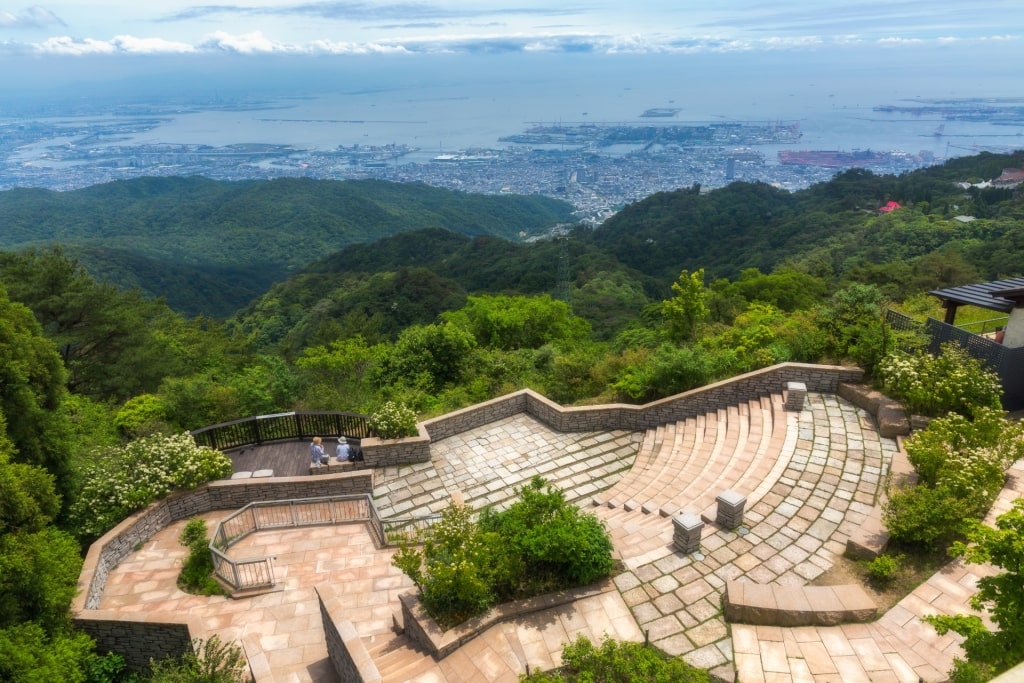
Mount Rokko
Mount Rokko is a Japanese mountain range reaching just over 3,000-ft-high, overlooking Osaka Bay and Kobe. It’s a scenic green escape for citizens of Kobe, Osaka, and Kyoto.
While you might not want to go camping, there are plenty of gentle walks or more vigorous hikes. There is also a golf course and an alpine botanical garden.
You can reach the top most easily by taking the Rokko Cable Car. From here, the Rokko Arima Ropeway connects to the Arima hot springs area. The views take in the city of Kobe and Akashi Kaikyo Bridge.
Restaurants and shopping at the top will tempt you to spend more time. There’s also the wonderful Musical Box Museum, with a sound-filled sensory garden.
Wander Through Nara Park
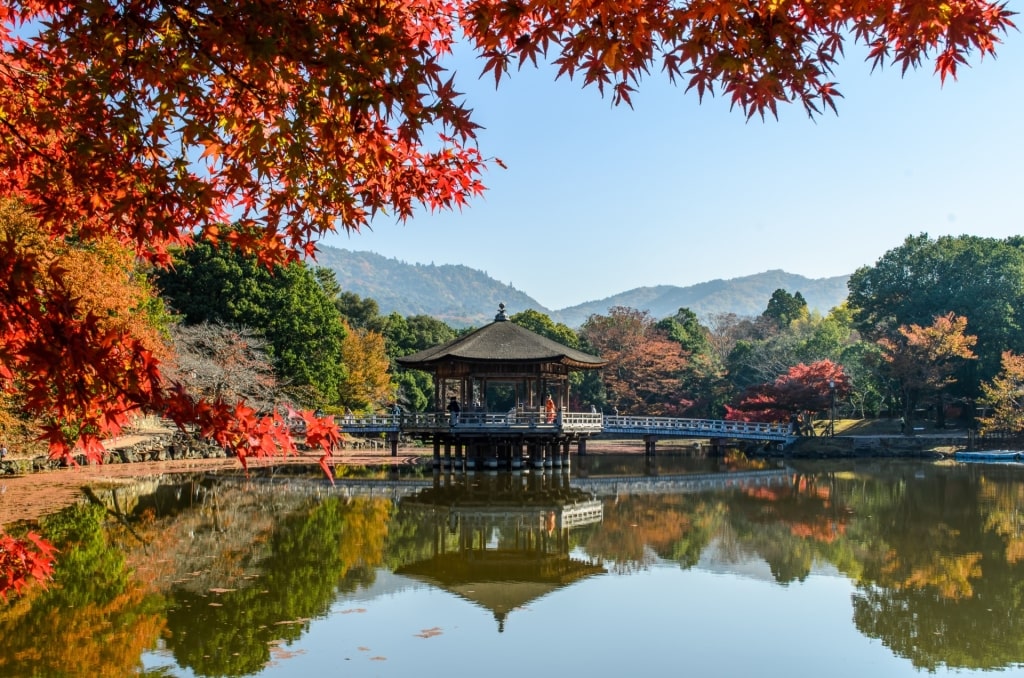
Nara Park
An hour away from Kyoto is Nara Park, one of the oldest parks in Japan. It was laid out in the 14th century when Nara was the country’s capital.
The park is most famous to visitors for its hundreds of wild sika deer. Considered sacred, they can be hand-fed with crackers you buy from vendors.
You’ll need a guide to discover the best of this vast area. The Unesco-listed Todai Temple and the Nara National Museum are highlights.
Leave time to just walk around and enjoy the paths, ponds, and gardens in the park. It’s perfect for picnics, so why not bring one yourself?
See the Great Buddha of Todai-ji
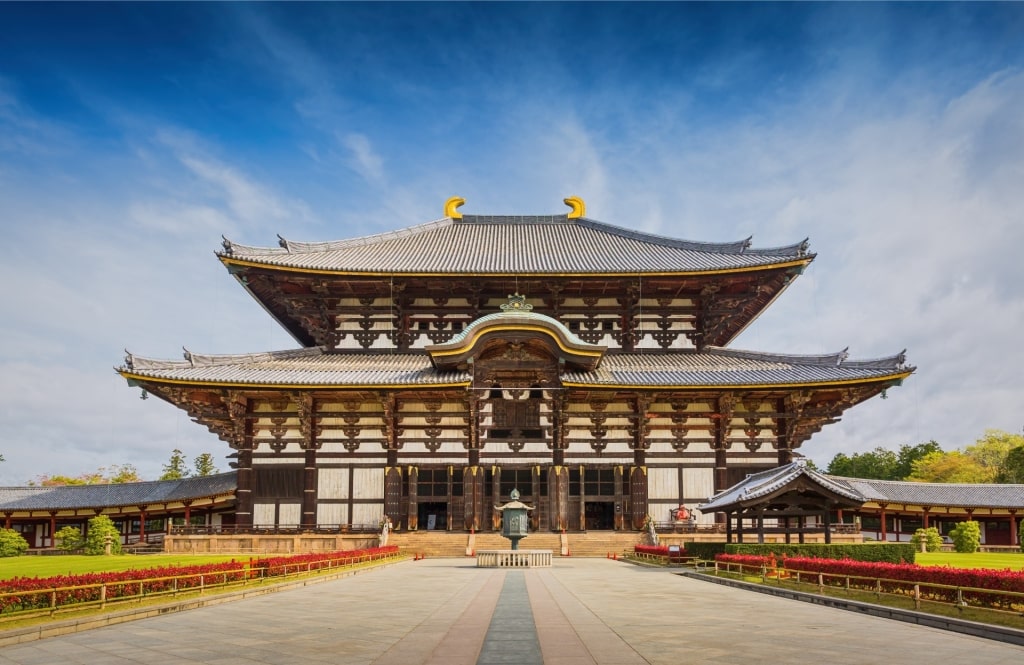
Todai-ji Temple
Todai-ji is one of the most significant buildings in Japan and the head temple of Japanese Buddhism. Built for the then-capital of Nara, it has stood here since the eighth century.
Its main hall, the Daibutsuden (Great Buddha Hall) is one of the world’s largest wooden buildings at 150-ft high. The “Great” name comes from the gigantic 1,200-year-old bronze statue of Buddha inside.
This Great Buddha weighs around 500 tons and is a symbol of Nara. The deer in Nara Park are also closely linked to the temple and to nearby Kasuga-Taisha.
As with most wooden buildings, the Japanese temple has been rebuilt several times, most recently in the 1700s. Besides the main building, there is a series of gates, pagodas, and other structures in the grounds.
Study Kasuga-Taisha
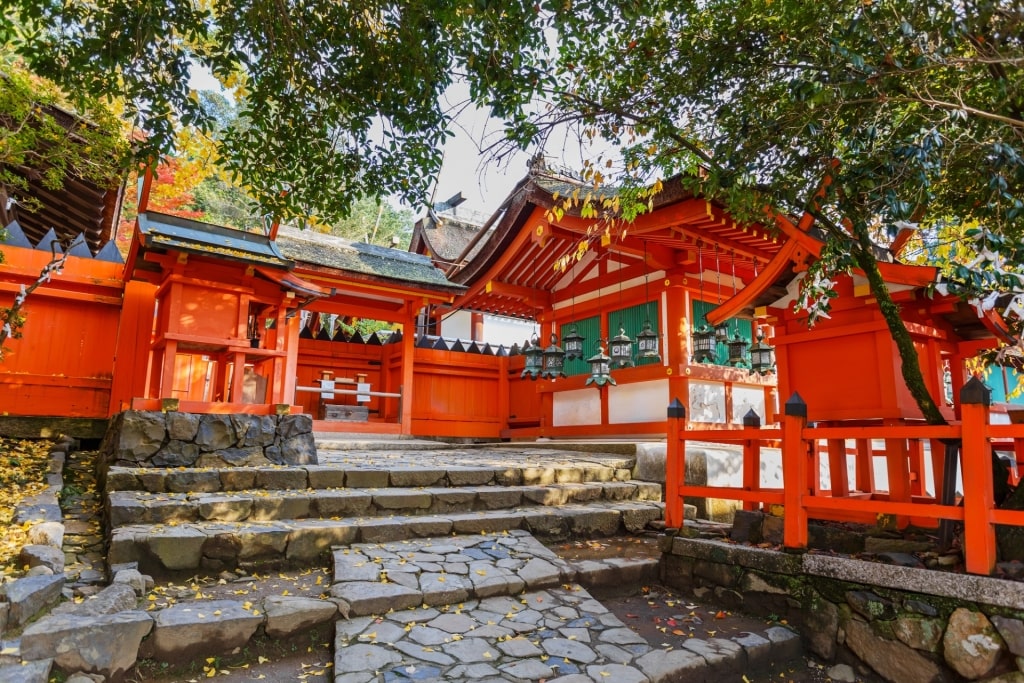
Kasuga-Taisha, Nara
Kasuga-Taisha is a major Shinto shrine in Nara dating back to 768 AD. It’s approached through Nara Park along a path lined with 2,000 stone lanterns.
Only a half-mile from Todai-ji, the two are often combined on tours. This allows visitors to study the differences between Shinto and Buddhist traditions and architecture.
The white walls, vermillion pillars, and Chinese-style roofs make Kasuga-Taisha very photogenic. There are 62 auxiliary shrines where you can better study the architectural detail.
The deer that roam the shrine and Nara Park, are considered messengers of the shrine’s Shinto gods. They supposedly all descend from one animal ridden here in mythology by Takemikazuchi, god of thunder.
Count 1,001 Kannon Statues
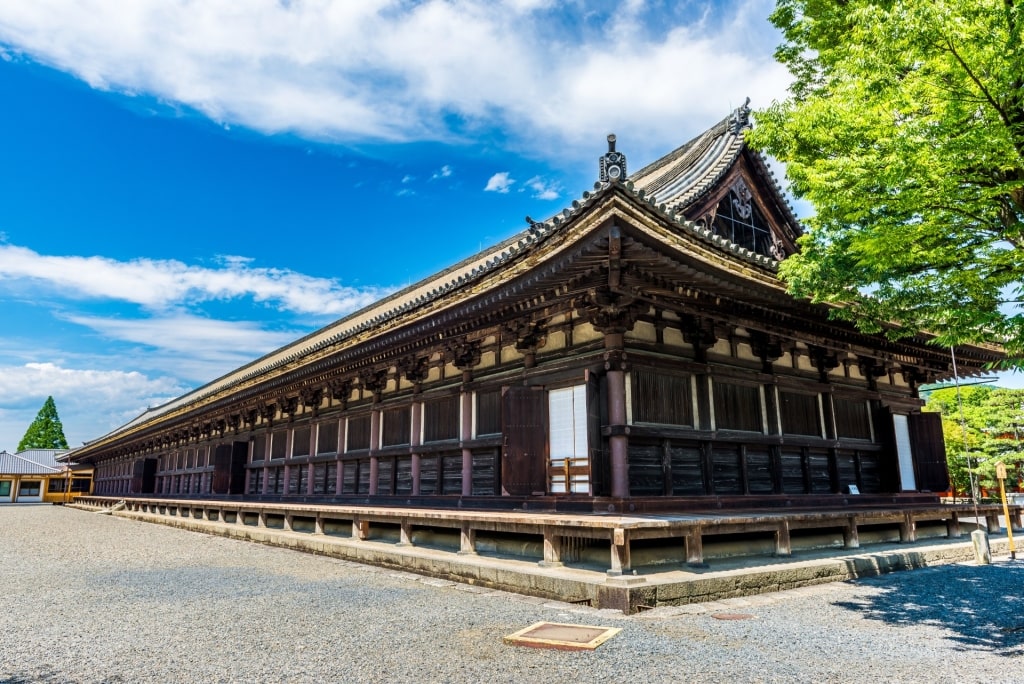
Sanjusangendo
At 394 ft long, the main hall of Rengeo-in is one of the world’s longest wooden buildings. That’s why this Buddhist temple in northeast Kyoto is known as Sanjusangendo (“Hall with 33 bays”).
The hall holds 1,001 life-sized statues of Kannon, the god of compassion. In legend, Kannon has 1,000 arms, but the images here each have a still-impressive 42.
These wooden statues were carved in the late 12th and early 13th century. The temple itself was founded in 1164.
Rengeo-in’s architectural style is a blend of Japanese and more continental Asian influences. Damaged most recently by WWII bombing, it has since been completely restored.
Pop into a Convenience Store
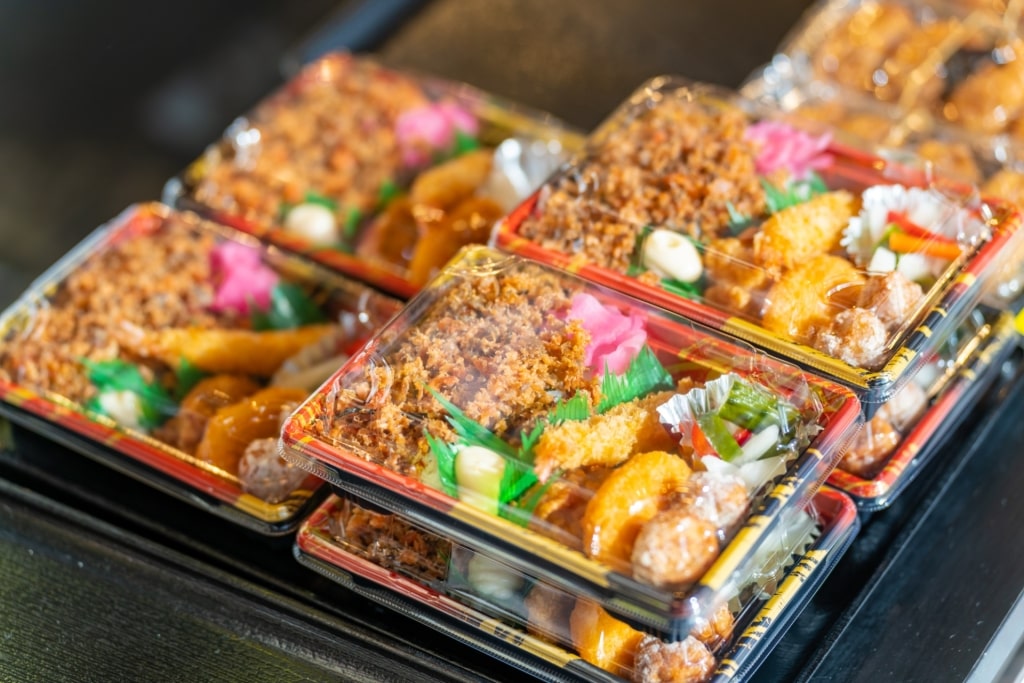
Convenience store in Japan
Tiny Japanese convenience stores, known as konbini, are a wonderland for visitors. Many are open 24/7 and offer everything from cold drinks to over-the-counter medicines and bloodthirsty manga comics.
For visitors, their greatest draw is the English language ATMs. That can be very useful in a country that still relies heavily on cash.
In Kyoto, you’ll find they often have local food specialities. They are also a good source of Kyoto-themed souvenirs such as fans or ornaments.
In Gion, you might find a konbini hidden in a renovated machiya—a traditional wooden house. Some even supply cultural experiences such as photos wearing a rented kimono, or calligraphy lessons.
Drive a Train
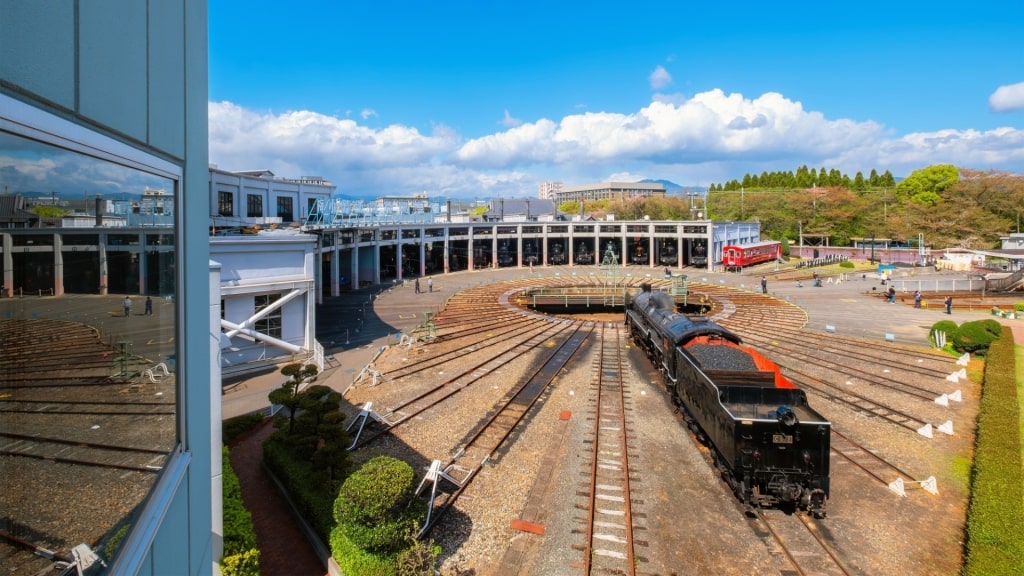
Kyoto Railway Museum
For any traveler who loves trains, the Kyoto Railway Museum is a delight. It details the evolution of Japan’s railways from the days of steam to the high-speed present.
There is a large outdoor area full of trains to explore at leisure. You can climb aboard carriages and examine steam locomotives, electric trains, and the modern Shinkansen (bullet trains).
Indoors, interactive displays let you experience the feel of driving a train, or changing signals. Vintage rail uniforms are displayed (with some available to wear for photos) and there’s an amazing rail diorama.
The museum’s gift shop will give you some lasting mementoes of your visit. Finally, the Sky terrace delivers an overview of the tracks feeding nearby Kyoto Station.
Experience the Tea Ceremony
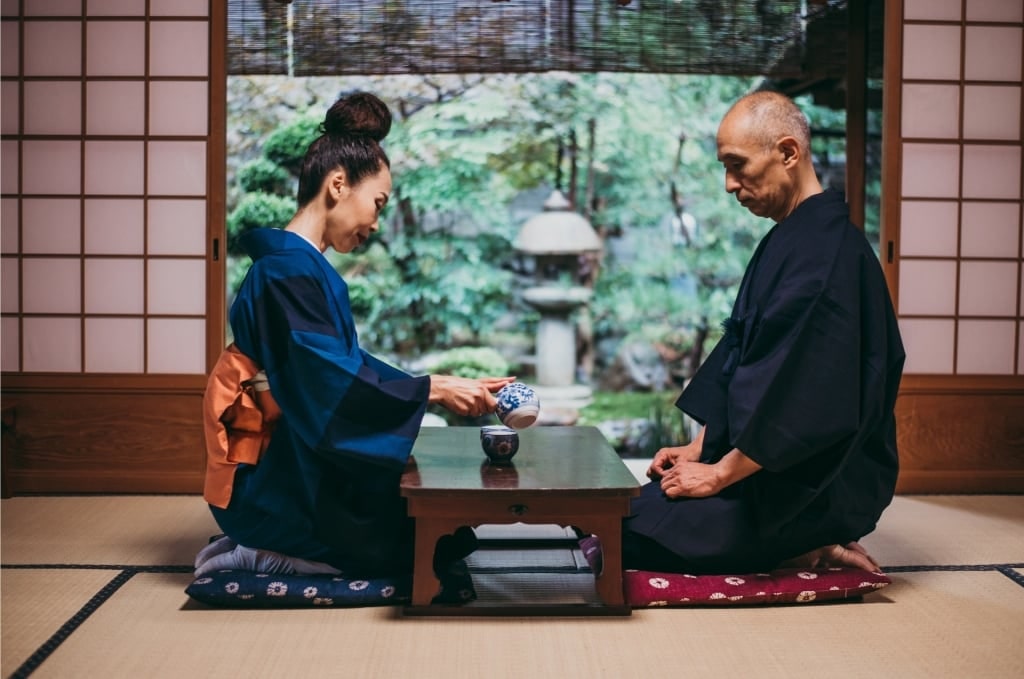
Tea ceremony in Japan
Kyoto is one of the best places in Japan to experience an authentic tea ceremony. Many teahouses will guide visitors through the experience with a multilingual instructor.
The tea ceremony originated in temples to show hospitality to travelers or other visitors. It then became linked through Zen Buddhism to the concept of being present in the moment.
Every step in the process, from opening the box of tea to talking with the host is important to the whole. You might not take the ritual back home but it could transform your attitude to a morning coffee.
The utensils used in the ceremony, such as whisks, cups, and trays, make for great souvenirs. You will find them for sale throughout Kyoto.
Have Fun in Kyoto Manga Museum
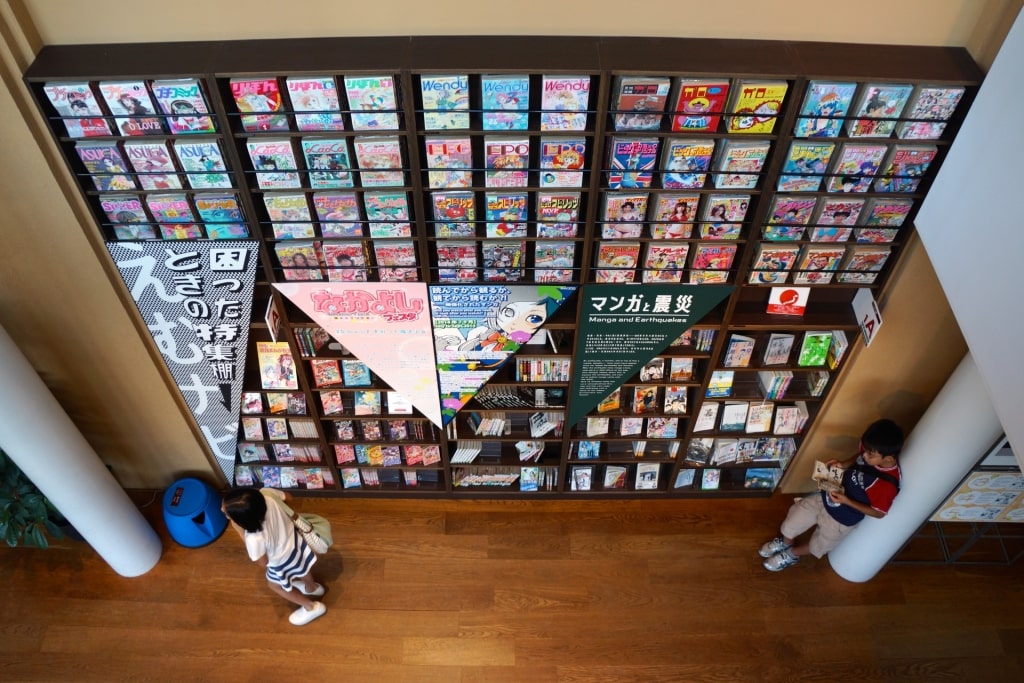
Kyoto Manga Museum Photo by Kentaro Ohno on Flickr, licensed under CC BY 2.0
A former elementary school from the 1870s makes a suitable setting for the Kyoto Manga Museum. What would those children have made of this vast assortment of Japanese comic books and graphic novels?
The earliest illustrations here are wood block prints from the Edo Period (1603-1868). The first comics on display date to 1912, while permanent exhibits show the very latest works.
Galleries feature original drawings by notable artists, as does the café. The museum has more than 300,000 items, with 50,000 volumes available to read, some in English.
Manga fans will go wild in the shop, which sells books, figurines, and lots more. T-shirts are a given, but can you resist having your photo copied in Manga style?
Go Potty at Kyocera Museum of Art
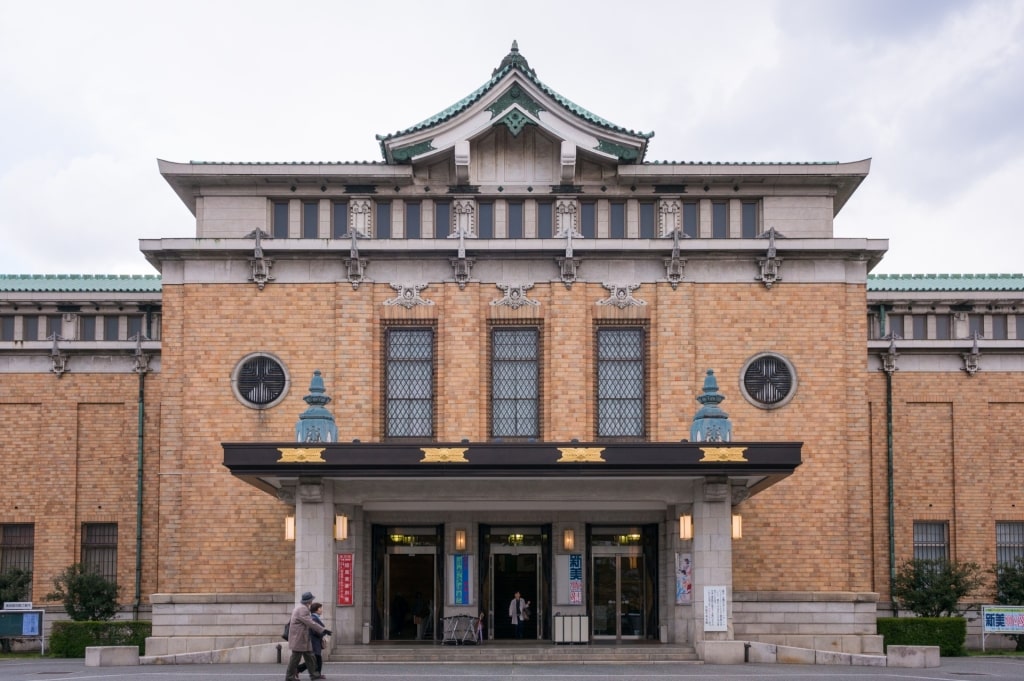
Kyocera Museum of Art Photo by Wei-Te Wong on Flickr, licensed under CC BY-SA 2.0
To understand Kyoto, remember that it was the center of the Imperial Court for more than 1,000 years. Its craftspeople perfected their art in everything from Japanese cuisine to kimono making.
Some of those skills are highlighted in the Kyocera Museum of Art, which focuses on pottery. There is also an impressive collection of painting and sculpture.
Its collection of more than 20,000 ceramic pieces ranges from ancient times to contemporary ceramic art. Works from China, Korea, and Southeast Asia feature strongly.
The building itself is of interest as an example of 1930s architecture. Mixing traditional Japanese with western style of the time, it has recently been sympathetically modernized.
Shop at Takashimaya
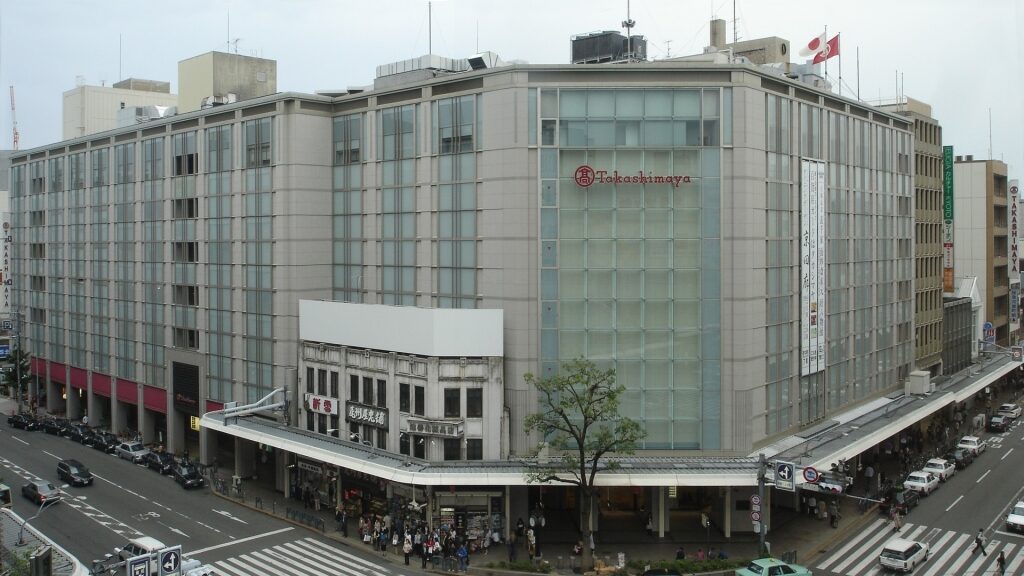
Takashimaya Photo by Shrr on Wikimedia Commons, licensed under CC BY-SA 3.0
Any Japanese department store is a wonder to first-time visitors. Kyoto was the 1831 birthplace of Takashimaya, now one of the most famous upscale chains nationwide.
Like any such store, there are multiple floors full of fashion, household goods, and electronics. Such similarities just highlight the many differences to discover in Japanese style, and the highest of high tech.
Search out the artistic wrapping service to add real value to any gift you buy. Then take a break in the food court for choices ranging from Kyoto kaiseki cuisine to Italian pasta.
Best of all are the basement food halls, full of gourmet surprises. There are plenty of tastings and even more choices for picnic treats.
Enjoy the Art at Hosomi Museum
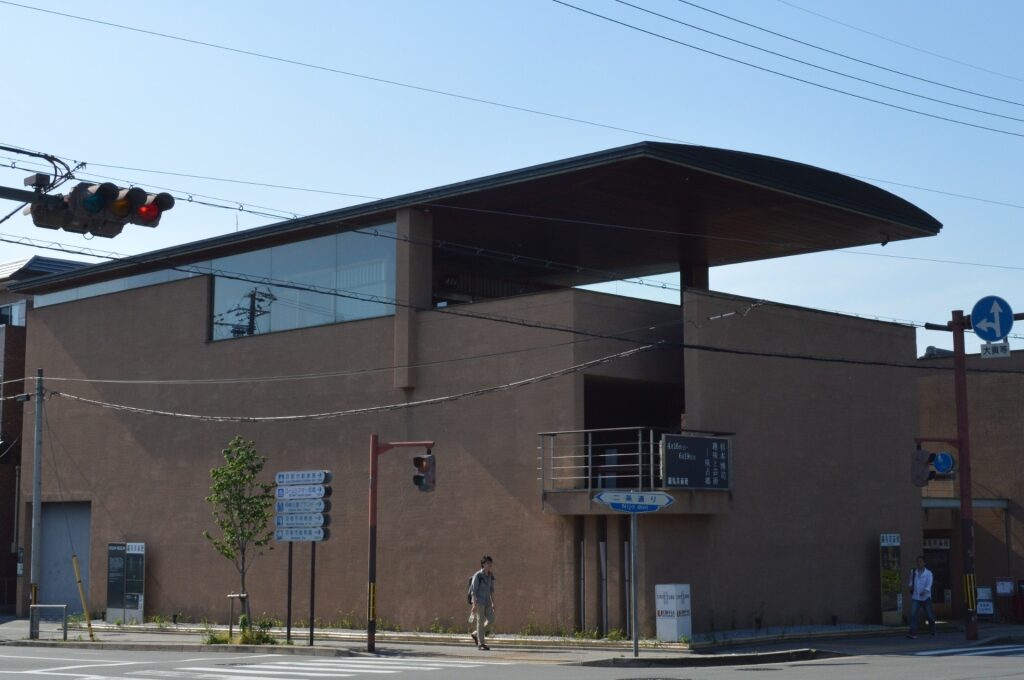
Hosomi Museum Photo by Asturio Cantabrio on Wikimedia Commons, licensed under CC BY-SA 4.0
The Hosomi Museum is built around the collection of the late Osaka industrialist, Hosomi Ryo. Its core is 1,000 works of art from almost all of Japan’s major time periods and style.
Designed by OE Tadasu, the museum building incorporates both old and modern design elements. There are three floors above ground, two below, and a traditional tea house in the gardens.
The museum is very strong in the decorative arts, such as lacquerware tea bowls and room screens. These are often displayed alongside artworks from the same time period.
The Art Cube Shop here carries a well-curated choice of gifts based on Japanese designs. There is also a comprehensive book store related to the arts.
Splash Out on Teramachi Street
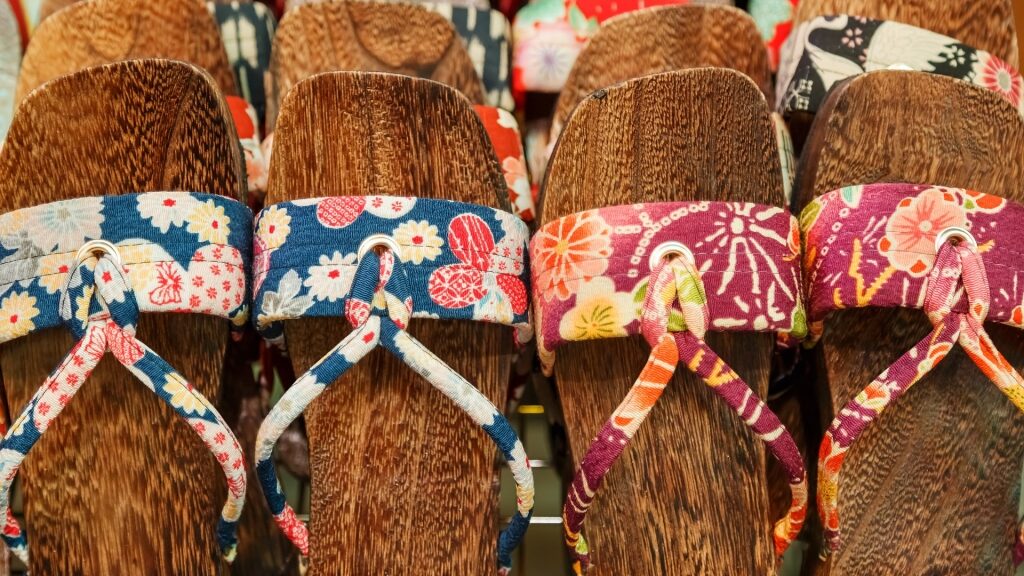
Japanese sandals
Teramachi is a hip shopping area full of modern fashion, confectionery shops, and artisan crafts. Whether you want a 1960s kimono or a handmade fan, this is the place to start looking.
Every turn brings a new surprise, from a comic store to shops specializing in Japanese beauty products. Here’s a place selling beautiful bowls, there’s another selling calligraphy supplies.
You can also find a cozy Izakaya (Japanese pub), cafés, and bakeries. Food shops will be proud to show off Kyoto specialities such as cinnamon.
Teramachi means “Temple Street” and you can still find stores selling objects linked to religion. These include lucky charms, incense, bells, and prayer beads.
Watch a Bunraku Show
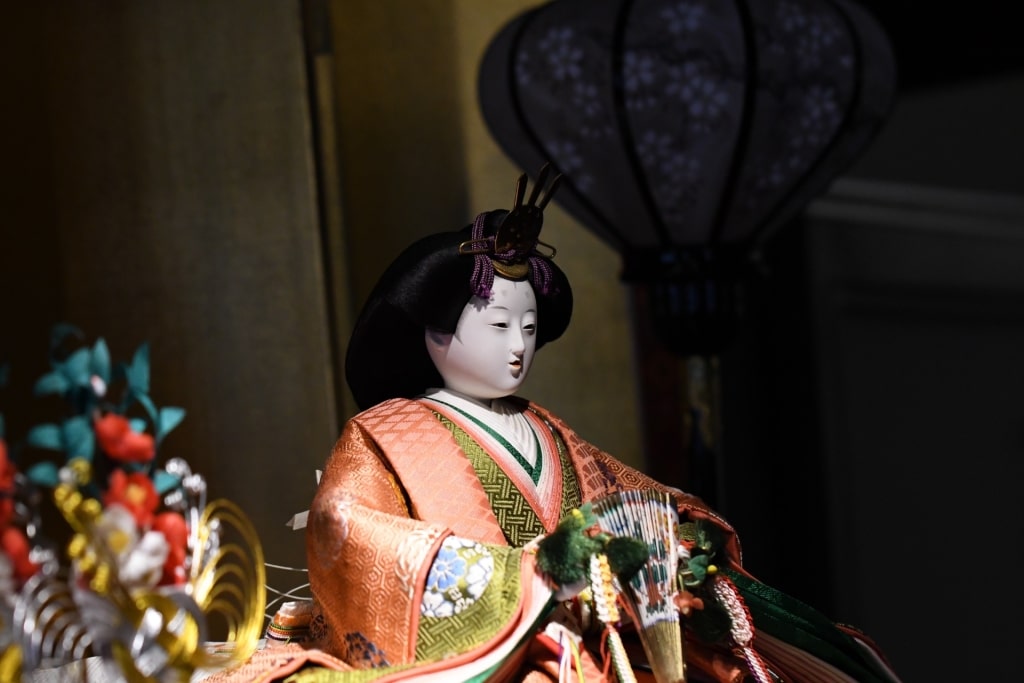
Bunraku show
At the National Bunraku Theatre in Osaka, you can watch performances by traditional wooden puppets. This artform dates back to the 1600s, when it began as street theater in Osaka.
The large wooden puppets are each worked by three puppeteers who are visible on stage. These artists need at least ten years of training, with the best considered living national treasures.
The stories involve ancient legends and tales of tragic love. There is a single narrator, accompanied by the music of a Japanese lute.
Five-hour evening and three-hour morning shows are the norm but you can buy a ticket to see an act of only one hour. These provide a more accessible taste of Bunraku, particularly for non-Japanese.
Read: Two Days in Kyoto
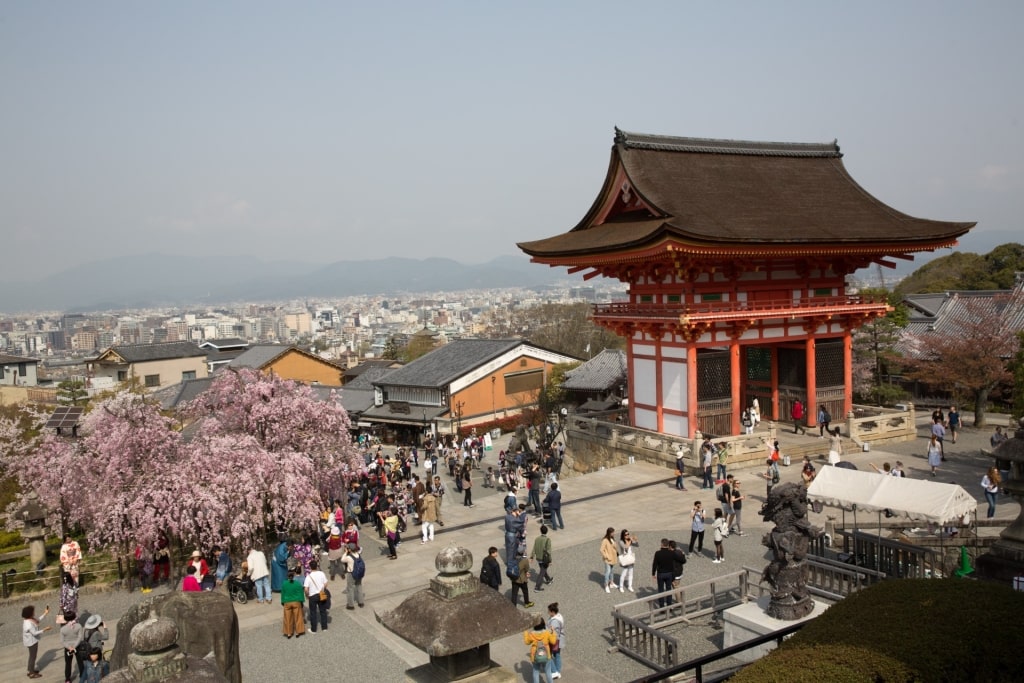
Kiyomizu-dera
Has this guide to the best things to do in Kyoto tempted you to visit? Then browse Celebrity’s Kyoto cruises to find the perfect vacation to Japan.
